
Features
Fabrication
Innovations
Thermal spray as a sputter target production method
New trends in rotatable target manufacturing for coating applications on glass
April 30, 2009 By Glass Canada magazine
Advanced coatings are right on target. Over the last 30 years, the
glass industry has increasingly introduced advanced coating
technologies to achieve value-added products for improved esthetics and
performance.
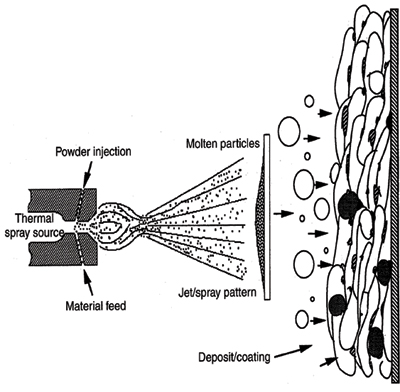 |
|
| Figure 1. A schematic representation of the thermal spray process flow and layer buildup.
|
Advanced coatings are right on target. Over the last 30 years, the glass industry has increasingly introduced advanced coating technologies to achieve value-added products for improved esthetics and performance.
Low-E glass, for example, has evolved considerably since its inception, spawning new variations of itself in high-performance and reflective glass. The rejuvenation of low-E in commercial glazing projects has been evident in several high-profile buildings in both Canada and the U.S. The advancements in glass coating technology for both the Pyrolytic and Sputtered processes have already produced a wave of “easy-clean” glass products and spectrally selective glass.
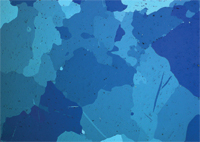 |
|
| Figure 2. Coarse grains in the High-Density Sn structure produced by the advanced thermal spray technology. |
|
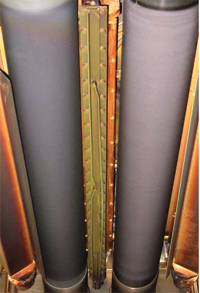 |
|
| Figure 3. Rotating cylindrical ITO targets mounted in a production sputter coater. |
While the end products are known, the process behind glass coating technology is complex, and some of the latest research indicates that vacuum coating by sputtering has established a leading position. This is because of its relative ease in scalability to high volumes and its wide variety of available materials and possible coating stacks for a variety of applications in the architectural, automotive and display markets.
Common glass coatings are for anti-reflection, low-emissivity (low-E), solar control and as transparent conductive oxides. In all of these fields, the desired functionality of the coating can only be achieved by a well-designed stack of multiple thin layers, consisting of pure metals, alloys and compounds.
Sputter deposition of metals and alloys is a quite straightforward DC process and mainly defined by the quality of the target material. However, the deposition of nitrides and the even more insulating oxides has evolved significantly and is typically performed by sputtering in a partially reactive gas to stabilize the process.
Studies show that the use of rotating cylindrical magnetrons instead of planar magnetrons has several advantages. A cylindrical target may contain more material and has a clearly superior utilization yield in comparison to planars, which results in much longer production runs and reduced downtime of the machine, increasing the throughput of the coating equipment. Another advantage is the possibility to use higher power densities because the heat load is divided equally over the circumference of the target to increase deposition speed.
A preferred method to produce these sputter targets is thermal spraying and the latest trends for some of these target materials are advancing.
Thermal spray process as a sputter target production method
Thermal spray is a generic term for a group of coating processes used to apply coatings with a layer thickness under 10 millimetres. The process uses a concentrated heat source to semi-melt feedstock materials, typically in wire or powder form. The resulting heated droplets are accelerated by process gases and propelled towards a substrate. Upon impact, the droplets are deformed to splats and solidify rapidly to form a coating. The thermal spray technology has grown from simple Zn and Al coatings to encompass most metals, alloys, ceramics, carbides, plastics, and nano-materials.
This versatility in feedstock materials is a major benefit of thermal spraying for sputter target manufacturing. In addition, thermal spraying is characterized by a high coating deposition rate. Because of the high cooling rates of the process the backing tube is hardly affected by any thermal interaction with the molten droplets so no diffusion layer between the substrate and the coating is formed. This means that the target material preserves its desired composition over the whole layer thickness and maximizes the utilization of target material for sputter deposition.
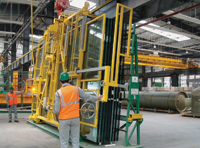 |
Sputter target materials
TiOx targets – The production of TiOx targets is a typical example of how the strengths of thermal spraying can be combined to result in a value-added target product. The high process temperatures allow the ceramic Ti- oxide to be melted and the high cooling rates result in a conductive TiOx material at room temperature.
The use of a Ti-oxide target instead of a pure metal Ti target increases the sputter deposition speed and enhances the process stability in reactive processes substantially.
Si(Al) targets – Si02 and Si3N4 thin films are sputtered starting from SiAl targets. The successful production of SiAl targets by thermal spraying takes advantage of key features of the spray process. Its inherent flexibility for target geometry allows a wide variety of target diameter, length, straight or dog-bone target ends, while maximizing the target sputter capacity by increasing the target layer thickness.
Sn targets – The latest development in Sn target manufacturing is the transformation of the standard thermal spray process into an innovative Advanced Thermal Spray Technology, capable of producing coarse-grained, high-density structures with controllable grain morphology.
Very fine splats of 10 pm by 100 pm in size, with an orientation parallel to the backing tube, give the Sn structure its typical layered architecture.
The very fine lamellar structure is substituted by coarse grains of about 200 pm by 1 mm in size.
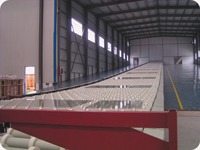
|
Sputter characterization of High-Density Sn has been performed on test targets in a lab-coater. The sputter behaviour has been compared to standard thermal sprayed Sn and cast Sn targets in terms of burn-in behaviour, arc rate, deposition rate and I-V characteristics.
Burn-in tests show a similar lower arc rate for High-Density and cast Sn targets, as compared to standard thermal sprayed Sn.
Besides the similar sputter behaviour of the High-Density structure compared to cast targets, the ability of the Advanced Thermal Spray Technology to adjust the coating structure (density and grain morphology) by controlled process parameter modifications is a powerful tool to further optimize the sputter process in terms of process stability (arc rates) and throughput (deposition rate).
ITO targets – ITO is one of the best performing transparent conductive oxides in thin film industry, combining a high visual transparency with a high electrical conductivity and stable thermal and chemical properties. The development of rotating cylindrical ITO targets is driven by the need to overcome some limitations inherent to the common planar lTO targets. These planar targets typically consist of ceramic tiles, bonded to a metallic backing plate.
Rotating cylindrical ITO targets have been developed by several manufacturing methods. All of the targets are designed as single piece components, with the bonding of the ITO layer to the backing tube generated during the target production process. The obtained densities vary between 92 per cent and more than 99 per cent of the theoretical value for ITO.
Large size prototype targets of 1700 mm in length and up to 4-mm layer thickness have been produced for sputter deposition testing on polymer web in different roll coaters.
The sputter behaviour of this rotating ITO targets has been compared with commercially available planar ITO tiles, consisting of various tiles bonded to a backing plate.
The process stability of the rotating cylindrical targets is similar to planar targets, all exhibiting a stable sputter voltage with low arcing rates during long sputter periods. Nodule formation did not occur on the rotatable targets after the sputter tests.
The optical light transmission measured before and after annealing of the ITO film, gives a systematically higher value for the rotating cylindrical target Resistivity values measured before and after annealing and after a chemical durability test, give similar results for both target types. The same conclusion applied to the grain size determination and the adhesion qualification.
Powerful coating technology for target manufacturing Advances in target manufacturing are being prompted by the increasing market and growing demand for thin film sputter deposition. This is focused primarily on the target materials for Ti02, Si02 and S13N4 and ITO films, which are commonly applied in coating stacks serving various applications such as anti-reflection, low-emissivity, (low-E) solar control and transparent conductive oxides.
Thermal spraying has proven to be a powerful coating technology for target manufacturing.
The key advantages of high process temperatures, partial reduction of the sprayed particles and high cooling rates allow the production of electrical conductive, suboxidic TiOx targets. These TiOx targets have increased sputter deposition rates in stable conditions. SiAl targets can be manufactured in a wide variety of target geometries and Al dopant level, with the Al homogeneously spread in the Si matrix.
By transforming the spray process into an Advanced Technology, High-Density Sn targets with controllable physical properties. This High-Density structures show similar sputter behaviour as cast Sn targets. The ability to fine-tune the spray process allows further optimization of sputter stability and yield.
Single piece rotating cylindrical ITO targets have already been developed. Comparisons to commercially available planar target shows comparable sputter behaviour and layer characteristics in terms of optical, electrical properties, thermal stability, grain size and adhesion to the substrate. Power densities can be increased by a factor of three compared to planar targets, resulting in a three times higher deposition rate.
Article derived from research paper titled “New trends in rotatable target manufacturing advances coating applications on glass” by authors Wilmert De Bosscher, Hilde Delrue, Anja Blondeel and John Van Holsbeke of Bekaert Advanced Coatings N.V., in Deinze, Belgium. www.bekaert.com/bac
Print this page
Leave a Reply